This contribution describes the key trends in the field of climate change for the European Union (EU). It starts with a European threat assessment regarding geopolitical relations in the Arctic region, discusses potential risks of heat, drought and flooding and describes the possible state of affairs in 2021. The contribution then provides an overview of how international cooperation in the field of climate change is organised, sets out the trends that can be seen in this context and discusses whether major changes relative to the current situation can be expected between now and 2021.
Threat assessment
Introduction
The Netherlands, the EU and other international organisations and groups like the North Atlantic Treaty Organisation (NATO), the United Nations (UN) and the G7 consider climate change to be a threat multiplier. In other words, climate change is seen as a factor that can combine with other risk factors and thereby undermine security. There is less consensus about the exact relationship between factors. ‘Alarmists’ stress that the effects of climate change in terms of food and water scarcity, migration and even war cannot be underestimated. ‘Moderates’ state that other factors play a greater role. This contribution focuses on the immediate security risks of climate change in the EU rather than on the threats that climate change poses in other parts of the world and the migration flows that can perhaps be linked to these threats.
The EU strategy for foreign policy adopted in 2016 (Global Strategy) states that the effects of climate change and environmental degradation (desertification, soil degradation and food and water scarcity, for example) increase the probability of conflict.[2] The three most important effects of climate change that have been identified in the EU are water shortages, the risk of floods, and extreme heat or rain in cities. The EU believes that these three effects could already have an economic impact in the current decade. Examples in this regard include damage to the built environment and agriculture caused by extreme weather, disruption of traffic and transport services, but also societal and ecological consequences like an increase in the incidence of certain diseases and a decrease in water quality.[3] Central and Southern Europe in particular may in the future face increasing water scarcity, which could drive up food prices.[4] The possibility of natural disasters and floods makes water security an issue in the Netherlands and the EU.[5] The Dutch Caribbean also appears to be vulnerable to climate change. Information on this particular subject is limited, however. The vulnerability of ICT and electricity networks during extreme weather, and an increase in the frequency of infectious diseases that occur in warmer parts of the world are also listed as threats.[6]
This contribution deals in greater detail with three subjects: Arctic sea ice, summer and winter temperatures, and floods. Table 1 shows the base rate and determining factors for these three subjects.
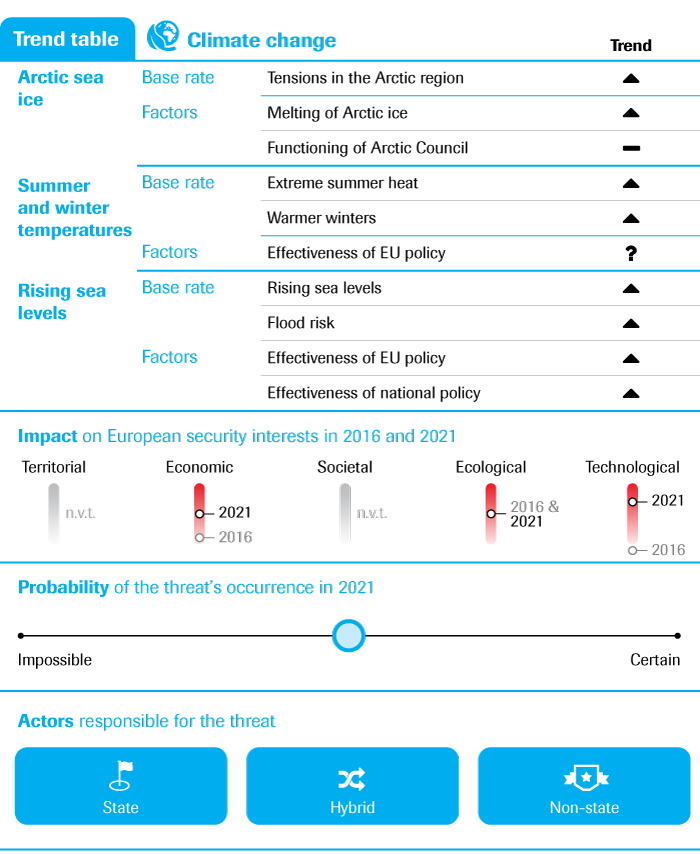
Arctic sea ice
Developments in the Arctic region have potential security implications because climate change is opening up new and shorter sea routes to Asia and making oil and mineral exploration easier. While these developments mean new economic opportunities, they are also giving rise to tensions because borders in the region are disputed between the NATO allies themselves and between the NATO allies and Russia. In addition to the United States (US) and Russia, other countries, such as China, are also trying to secure a position in the region.
The base rate
It is difficult to state how tensions in the Arctic region are developing. While there has clearly been a sharp increase in the number of military bases and operations, most increases in military capabilities are primarily the result of modernisation.[7] The main purpose of these increases seems to be the protection of recognised national territories and the environment and protection against illegal activities. Since the rise in tension between the West or NATO and Russia in 2014, there has been cause for concern because conflicts elsewhere threaten stability in the Arctic region.[8] Continuing political tensions between the West and Russia are considered to be the most important potential source of possible military tensions in the region.[9]
In addition, there appears to be greater disagreement regarding the Exclusive Economic Zone (EEZ) in the Arctic region, as a result of which territorial claims overlap (see Figure 1). According to the UN Convention on the Law of the Sea, states may control part of the seabed as long as the part is an extension of their continental shelf. Under this convention, Denmark (through Greenland), Canada and Russia are claiming the same slice of the North Pole pie in an effort to secure access to the region’s natural resources. Russia recently resubmitted an application for the expansion of the Russian zone, where the US, Canada, Denmark and Norway also claim jurisdiction. In 2014, Denmark also decided to submit a claim relating to this region (the Lomonosov Ridge). This part of the Arctic region possibly contains 30% of the world’s natural gas reserves and 15% of its oil reserves. Sea routes may also become available in the region.

Determining factors
The base rate with respect to tensions in the Arctic region is far from clear. The way in which individual trends increase or reduce tensions is likewise unclear. This contribution considers two key factors: developments regarding Arctic ice and the ability of the Arctic Council to provide solutions (see Table 1).
Tensions can be expected to rise in the coming five years, largely because of opportunities created in terms of sea routes and natural resources exploration by the further retreat of sea ice in the summer months. The average sea ice extent has decreased dramatically in the past decades. Each year, Arctic sea ice shrinks to its minimum extent at the end of summer, usually in September. The absolute lowest minimum extent observed was reached in September 2012 (3.34 million square kilometres). The Intergovernmental Panel on Climate Change (IPCC) defines a nearly ice-free Arctic Ocean as being one in which sea ice extent is less than 1 million square kilometres in September. According to model simulations included in the IPCC’s fifth assessment report (2013), this minimum could already be reached in 2040. This particular rate of sea ice decline is based on the scenario with the highest level of greenhouse gas emissions (RCP8.5). The process takes longer in other scenarios (after 2060 at the earliest).
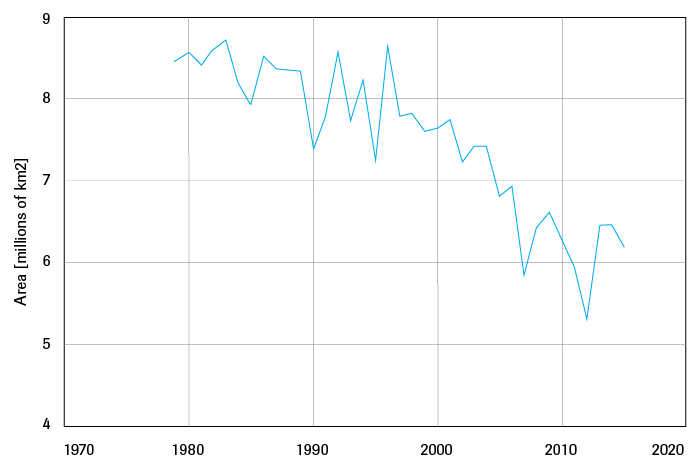
Exploring for natural resources and using sea routes in the Arctic region are becoming more attractive because of the melting of the sea ice. A number of projects for the exploration of natural resources were suspended as a result of Western sanctions against Russia. The sea routes are perhaps of greater interest to the Netherlands. The expectation is that the northern route that could be used by vessels travelling between the Port of Rotterdam and Asia will in the future be navigable for eight months a year. Sailing from China to Rotterdam would take 35 days rather than the 48 of the Suez Canal route.[12] At present, using the Arctic sea routes entails many risks and substantial costs because of the extreme weather in the Arctic region, the shallow water, high insurance premiums and the limited infrastructure. The expectation is that with the further melting of Arctic sea ice, the new routes could become profitable sometime between 2030 and 2050.[13]
A second key factor concerns the functioning of the Arctic Council, in which the Netherlands has the status of observer. Established in 1996, the Arctic Council is a pragmatic partnership, not a formal international organisation. It is not a decision-making body as such and does not have legal personality. The Arctic Council has so far succeeded in limiting tensions. As the Advisory Council on International Affairs has stated, however, the Arctic Council is an organisation with limited clout; ‘it is not an international organisation and does not function as one’.[14] In addition, because of current developments, particularly those that have unfolded since 2014, the Arctic Council is increasingly having to deal with security issues over which it has no control. Tensions in the region could therefore rise.[15]
Summer and winter temperatures
A second security interest for the EU concerns warmer seasons. Less cold winters can result in diseases in plants (also agriculture) and animals, and possibly also in humans, while extreme heat in summer can result in the (earlier) deaths of people.
The base rate
Together with the increase of the average temperature, the summer temperature is also rising. In the period 2000–2015, the summer temperature in Europe was an average of 1.2 degrees higher than it was in the period 1900–1975 (see Figure 3). The frequency of very warm summers, such as those of 2003 and 2006, has also increased. In addition, the probability of heat waves is increasing. The very high night temperatures during heat waves can damage health. The number of heat waves is expected to rise sharply in the future. This increase could mean the early deaths of 26,000 people in 2020. The figure could even rise to 89,000 early deaths a year by 2050.[16] The average winter temperature in Europe is also rising. It rose by almost 0.9 degrees in the period 2000–2015 relative to the period 1900–1975 (see Figure 4). The variation in winter temperatures from year to year is greater than the variation in summer temperatures. Winter temperatures are expected to rise further in the future.
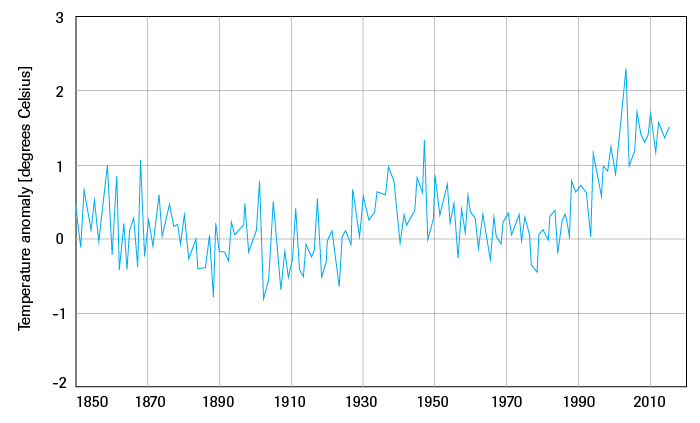
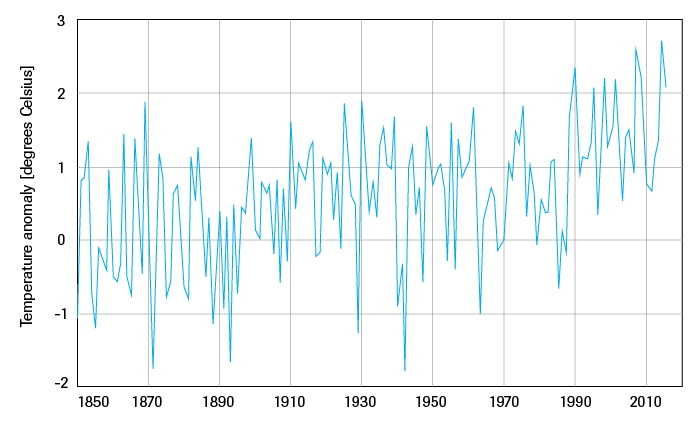
Milder winters and warmer summers will mean more frequent and more intensive periods of heat and drought and therefore greater water scarcity in the European territory. The southern member states are increasingly having to deal with the effects of heat and drought, such as desertification. The northern and water-rich states are also vulnerable to drought because of a lack of infrastructure for water storage.[19] Heat and drought cost the EU an estimated 6 billion euros a year.[20] In addition, the main negative effects of rising temperatures will be seen in agricultural production. In the southern regions, heat and drought make agricultural land less productive. Although climate change in Northern European countries can also have a positive effect on food production,[21] more frequent extreme weather conditions threaten harvests in the entire region.
Determining factors
Winter and summer temperatures will increase in the EU in the coming years. The degree of this increase depends on a large number of factors, including the success of the current European adaptation policy.[22] In the period 1990–2014, greenhouse gas emissions decreased by 22% in the EU-28, which means that the 2020 target of a 20% reduction has already been achieved.[23] Nevertheless, a regional temperature increase is inevitable even in the most favourable emission reduction scenarios. It is important to note in this regard that the degree to which the base rate will continue does not depend solely on European climate policy. The success of global mitigation efforts will also be a determining factor. If these efforts prove to be inadequate and emissions remain at the same level in the coming decades (substantial reduction efforts are already required to prevent ‘business-as-usual scenarios’ from occurring), the global temperature will increase by two to three degrees Celsius.[24]
Those in European policy circles recognise the urgency of the problem of increasing water scarcity as a result of warmer winters and summers. In 2007, the European Commission (EC) issued a statement in which it acknowledged the problem and set out action points aimed at countering the decreasing water security.[25] A policy review carried out in 2012 showed that while steps had been taken to implement the action points, the trends of increasing drought and water scarcity had not changed. Moderate implementation of EU policy by member states, particularly in quantitative terms, and a lack of focus on underlying driving factors constitute key obstacles.[26]
Despite the inadequate implementation of the adaptation policy, other factors will mitigate the security threat posed by a rise in temperature. Examples in this regard include the diversified economies in the EU, the ability to adapt to climate conditions with the aid of new technologies and highly developed political institutions.
Sea level rise and the risk of river flooding
Another possible threat to European security as a result of climate change is the rise in sea level and the associated risk of flooding.
Base rate
The global average sea level is rising by approximately 3 millimetres a year because ocean water temperatures are warming and the ice sheets are melting. This increase is based on data obtained by means of tide gauge measurements and satellite observation (see Figure 5). The rise in sea level can vary according to region because local decreases (settling) or increases (effect of the last Ice Age) are factors. The sea level is expected to rise further in the future, possibly at an accelerated rate depending on the rate of warming and the potentially more rapid melting of Greenland’s and Antarctica’s ice sheets. Because of a slowdown in the warming of the oceans, the rise in sea level will continue also after the end of this century (2100). In addition to the rise in sea level, the risk of flooding is becoming greater because the peak discharges of the major rivers is increasing as a result of changing rainfall patterns and an increase in the occurrence of extreme rainstorms.[27] The economic damage caused by river flooding in Europe could rise to 10 billion euros a year. Regarding sea level rise, economic losses could amount to approximately 42 million euros a year.[28] In the event of a medium emissions scenario without climate adaptation, approximately 300,000 people a year in Europe will be affected to varying degrees by river flooding by 2050. In the event of a high emissions scenario coastal flooding could claim up to 3,000 victims a year by around 2080. Two-thirds of these victims would be residents of Western Europe. Adaptation measures could reduce that risk to fewer than 10 deaths a year by 2080.[29]
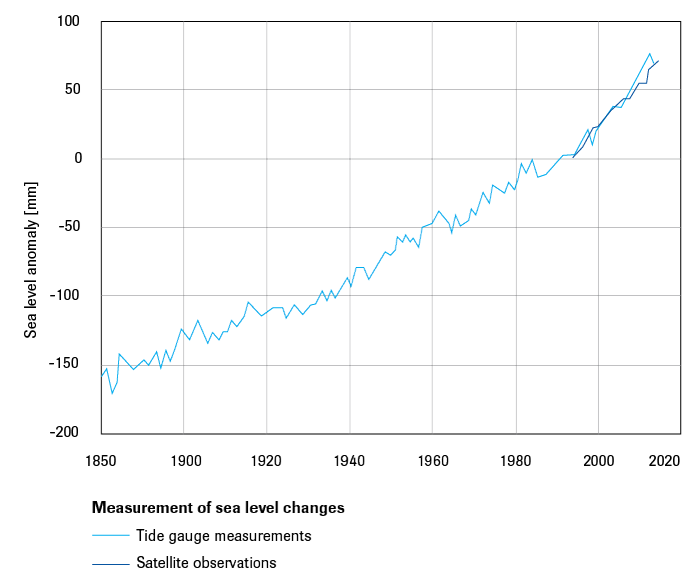
Determining factors
Although a rise in sea level is inevitable, the magnitude of the rise depends on several factors. This contribution considers the policy of the EU and the policy of the Netherlands. Both factors appear to have a mitigating effect on the base rate of sea level rise.
The EU’s approach largely consists of two policy lines. The EU Directive on the assessment and management of flood risks (Flood Risks Directive) was adopted in 2007 and builds on the EU Water Framework Directive, which was adopted in 2000. The aim of the Flood Risks Directive is to minimise flood risks to human health and life, the environment, cultural heritage and economic activity.[31] The Flood Risks Directive required member states to complete a preliminary flood risk assessment by 2011. River basin districts and coastal areas at risk of flooding were to be identified to enable the development of specific policies to manage the risk. Flood risk maps on the basis of which flood risk management plans could be drawn up were to be prepared for these risk areas by 2013.[32]
The first implementation round ended in 2016 and the second round, the first step of which was likewise the completion of a preliminary flood risk assessment, has started. The first management plans must be implemented and the new generation of management plans must be updated between 2016 and 2021.[33] While the 2016 results of the plans are still unknown, the initial signs are favourable. All member states with shared river basin districts cooperated and coordinated their findings for the risk assessments and preparation of flood risk maps. The International Commission for the Protection of the Rhine (ICPR) was one of the leaders in terms of cross-border cooperation, for example.[34]
A second factor concerns the policy of the Netherlands. In connection with the Flood Risks Directive, the Netherlands is focusing primarily on improving existing programmes and on possibilities to coordinate measures with European neighbours. The Netherlands is active in the International River Commissions for the Rhine, Meuse and Scheldt, as well as in the Ems International Steering Group, for example.[35] The Delta Programme is ensuring proper preparation for the effects of climate change in the Netherlands. The programme includes a protection level pursuant to which the likelihood of an individual dying as a result of a flood must remain below 0.001% per year. This norm is used to determine which water defences require more investment.[36] The Delta Programme is limited to the risks within the borders of the Netherlands.
Impact and shocks
What is the threat assessment for 2021? What can be expected in the Arctic region and what threats will there be in terms of floods, heat and drought? Tensions in the Arctic region will have a limited effect on the probability of conflict (see also the Clingendael Expert Survey). Nevertheless, if a conflict breaks out, there could be major consequences for the Netherlands as well because Article 5 of the North Atlantic Treaty obliges the Netherlands to assist its NATO allies. In addition, climate scientists frequently refer to risks with higher margins of uncertainty. Examples in this regard include the melting of the permafrost in Siberia and, in the context of climate change, the very damaging methane gases that would then be released, the coming to a halt of the Gulf Stream and the occurrence of tornados in the Netherlands. Regarding heat, drought and also floods, it seems that the threat level for the EU will increase in the future.
These expectations are based on observable trends. It is possible that ‘unexpected’ events will occur, however. The Clingendael Expert Survey analyses these shocks to ascertain the degree to which and the way in which they could affect the climate (see Figure A in the pop-out window). The experts that took part in the Clingendael Expert Survey believe that a failure of climate adaptation (adapting to changes) and climate mitigation (reducing greenhouse gas emissions) would have a large to very large impact on European member states and that this threat will probably remain.
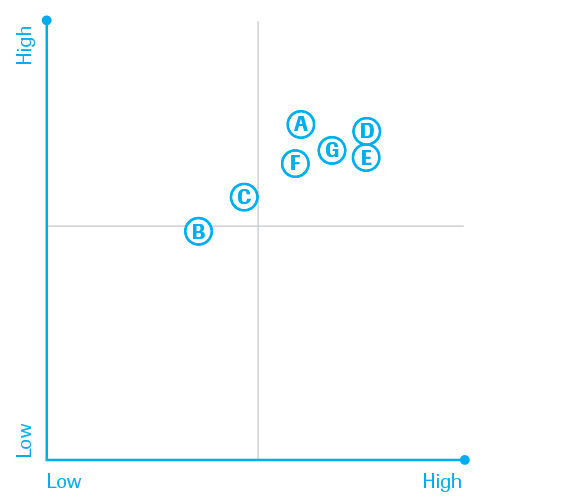
Shock
The international climate change regime
What does the international system in the field of climate change look like and what are the expectations for 2021? The expectations are positive and stable: a multilateral agreement regarding underlying rules and a set of norms will continue to apply until 2021. This contribution discusses the key institutions and actors, developments in the field of norms and rules, the degree of compliance with existing agreements and trends in these areas.
Actors and institutions
In light of the past ten years, it can be expected that global cooperation between states in the field of climate change will continue to yield concrete results and that new (non-state) actors will launch their own initiatives.
The UN Paris Climate Change Agreement under which countries politically committed themselves to national targets to reduce greenhouse gases is seen by many as proof that multilateral cooperation is still possible in the 21st century.[37] The agreement was concluded during the 21st session of the Conference of the Parties to the United Nations Framework Convention on Climate Change (UNFCCC). This convention was negotiated during the Earth Summit in Rio de Janeiro. Its objective is to combat dangerous climate change and it provides a platform for annual conferences in which countries can hold further negotiations on climate measures.
The Kyoto Protocol was adopted during a session of the Conference of the Parties (COP) in 1997. The protocol committed industrialised countries to reducing their greenhouse gas emissions relative to 1990 levels. The problem with the Kyoto Protocol was that the US refused to ratify it because it did not include obligations for emerging economies like China and India. Since there were still many leading politicians in the US who challenged climate science, the internationally binding nature of the Kyoto Protocol was also considered to be a problem. The EU decided to fight for the survival of the Kyoto Protocol and succeeded in persuading Russia to ratify it as well. The protocol therefore entered into force in 2005. Other countries, such as Canada and Australia, later withdrew. Since 2012, the Kyoto Protocol has therefore been a treaty that de facto has a reduction target only for European countries. For this reason, the Paris Agreement and the fact that this agreement has entered into force are of great importance. Following an earlier failed attempt in 2009 (Copenhagen), efforts to commit countries to national targets succeeded in Paris. Countries also agreed to meet every five years for the purpose of setting more ambitious national targets. The first of these meetings will take place in 2018.
The Paris Agreement was concluded in the context of the UNFCCC. Climate change is also discussed in a number of other international forums. In New York, climate change was on the agenda of the UN Security Council (most recently in 2015) and was also on the agenda of the General Assembly on several occasions. In addition, climate change has been frequently discussed by the G20 and G7, for instance in 2015 in relation to security risks in more fragile states. Climate science is discussed in bulky reports of the IPCC. A multiplicity of international funds and organisations focus on funding climate policy in terms of measures to reduce emissions and measures aimed at making countries more resilient against floods, for example. Examples in this regard include the World Bank, regional development banks and the Green Climate Fund, which was established in 2010 and is based in Incheon, South Korea.
Action regarding climate change is not only being taken by state and interstate actors. There has been a lot of criticism about the slowness of international negotiations and the meagre results of such negotiations. Some multinational companies (such as the members of the World Business Council on Sustainable Development) and mayors of large cities (such as C40 and the Global Convenant of Mayors) appear to be more ambitious. The pope and other influential individuals like Al Gore, who received the Nobel Peace Prize together with the IPCC in 2007, and Leonardo di Caprio are also making efforts to highlight the importance of combating climate change. The increase in the number of organisations that focus on climate change is also shown by figures included in the Yearbook of International Organizations: from 28 in 2006 to 35 in 2016.
Norms and rules
Table 2 provides an overview of the key norms and rules. What trends can be seen with respect to fundamental norms and agreed rules of conduct?
|
Norms |
Rules |
|---|---|
|
The prevention of dangerous climate change. |
Global average decrease in greenhouse gases of 5.2% between 2008 and 2012 (Kyoto Protocol). |
|
Common but Differentiated Responsibilities. |
Limit the rise in temperature as a result of climate change to 2, preferably 1.5, degrees Celsius (Paris 2015). |
|
Precautionary principle: even if there is no scientific consensus, policymakers must take action against harmful substances if there are potentially major risks to the environment or health. |
EU targets for 2030 are a reduction of CO2 emissions by 40% relative to 1990, 27% renewable energy and an increase in energy efficiency of 27%.[38] |
|
Compliance with European targets as part of the ratified Paris Agreement and the setting of more ambitious targets every five years. |
The Paris Agreement addresses the most important trends. It was agreed that countries will limit the average rise in temperature as a result of climate change to 2, preferably 1.5, degrees Celsius above pre-industrial levels.[39] In other words, there is already normative agreement about the fact that the climate is changing and that joint action must be taken to prevent dangerous climate change. The recent Sustainable Development Goals (SDGs, specifically number 13) adhere to the same line by stressing the need to implement changes as soon as possible.[40]
Another important trend concerns the ‘Common But Differentiated Responsibilities (CBDR)’ norm: all countries are responsible for dealing with the climate problem, but not all to the same degree. The CBDR principle is included in the UNFCCC and applies to both emission reductions and the funding of climate policy. The issue as to the responsibilities borne by each country was a sticking point between affluent and poor countries for many years. It proved difficult to determine how much each country should contribute and negotiators could always find arguments as to why other countries should be doing more than their own respective countries. In addition, the largest polluters had withdrawn (US) or did not have a reduction obligation (China, India and other countries). The political stalemate with respect to implementation of the principle was circumvented by a request to introduce Intended Nationally Determined Contributions (INDCs). These INDCs were later included in the Paris Agreement and differ in terms of form (the economy as a whole or per sector relative to a base year, an absolute figure relative to a trend and so on). INDCs are therefore easy to apply in the context of a specific national situation but difficult to compare in an international sense.
Another important development is that, in addition to adaptation and mitigation, a kind of third pillar, namely the Warsaw International Mechanism for Loss and Damage associated with Climate Change Impacts, has been a factor in international climate change negotiations since the Warsaw Climate Change Conference (2013). This mechanism relates to all damage and impacts that cannot be prevented by mitigation and adaptation efforts and for which rich countries may have to provide compensation. Until now, the countries concerned, including those in the EU, have been very wary about accepting legal liability for climate change. Nevertheless, the subject is now being debated and a reference to the loss and damage principle is included in the Paris Agreement.[41]
Compliance
In light of the past ten years, what can be expected in terms of compliance in 2021? Based on experiences with the Kyoto Protocol, there are certainly no guarantees that countries will comply with the agreements made. In addition, it has become apparent that few countries are willing to limit opportunities for economic growth because of international climate agreements. While this lack of willingness is very clear in emerging economies, reducing emissions is also a challenge in the Netherlands. At the same time, however, it seems that the energy transition has really started and that investments are shifting from fossil fuels to renewable energy sources. In addition, there is reason for hope in that a large number of countries committed themselves to an INDC as part of the Paris Agreement.[42] The actual level of commitment of companies and cities remains to be seen, however. There are few specific criteria for the monitoring of results, let alone sanctions for failures to comply.[43] It is important to realise that although the Paris Agreement includes binding best efforts and reporting obligations, the INDCs are, for virtually all countries, essentially voluntary. The Paris Agreement is therefore less binding than the earlier Kyoto Protocol. It must be noted in this regard, however, that the Kyoto Protocol only had emission reduction targets for rich countries, several of which did not ratify or implement the treaty (US, Canada, Australia and Japan).
Climate change agreements are becoming increasingly binding at EU level. EU compliance at supranational level is absolutely binding.[44] Companies and member states that fail to perform their obligations risk heavy fines. The climate and energy package for 2020, when what are referred to as the 20-20-20 targets must be achieved (20% reduction in CO2 emissions relative to 1990, 20% improvement in energy efficiency and 20% of EU energy from renewables), includes rules. The targets for reducing emissions and renewable energy were transposed into mandatory law at European level.[45] As at the time of writing, negotiations on the transposition of these targets into European law were still taking place in Brussels. There are regional differences regarding compliance with the EU climate targets, however. The Dutch government has to deal with a court decision that enforces climate policy, for example.[46]
The agreements at international level are considerably more voluntary in nature and it remains to be seen what will happen if countries fail to comply with their respective INDCs. Despite the ambitious targets, limiting the temperature rise to 1.5–2 degrees Celsius depends on global emission reductions. Success in this regard depends on both the degree to which industrialised countries succeed in reducing their greenhouse gas emissions and the degree to which emerging economies succeed in limiting their emission increases. The current INDCs as a whole are not enough to achieve the climate targets of the Paris Agreement and are very likely to result in a temperature rise of 3.5 degrees by the end of this century.[47] While the EU is on course to achieve its target of a 40% reduction in emissions relative to 1990, this target is also not enough to remain within the temperature-increase range of 1.5–2 degrees. Accelerating the annual reduction of emissions is essential to achieving the long-term target of a reduction of 80–95% (consistent with the Paris Agreement). The introduction of a more effective Emissions Trading System (EU ETS) and accelerating the development of sustainable energy are the key challenges in this regard.[48] To achieve compliance with the Paris Agreement, it is therefore necessary to ensure that the allocation of emission allowances will play a greater role in the long term if the INDCs as a whole also prove to be inadequate in the coming years. It is possible in this context that political discussion between industrialised countries and emerging powers will play a decisive role in compliance with the climate change agreement.
The quadrant chart and shocks
All in all, the climate change regime is a fairly state-based system in which a heterogeneous group of states makes decisions and determines the agenda. Despite the emergence of non-state actors like cities, companies and organisations like the IPCC, it is unlikely that the dominance of states in determining climate policy will have changed much by 2021.
In addition, there is agreement regarding the norms and rules within the system and a reasonable degree of cooperation. The recent climate change agreement reconfirms this state of affairs and it therefore seems that no major changes will occur between now and 2021 (see Figure 6).

The question is of course how stable this assessment is. To ensure the greatest possible accuracy, this contribution uses the results of the Clingendael Expert Survey, which was carried out among a large group of climate experts (see Figure B). According to these experts, a collapse of the Paris Agreement would have a large to very large impact on international cooperation in the field of climate change. The experts are of the opinion that this shock is unlikely to occur. It is unknown what would happen if the US withdraws, however, something that is no longer inconceivable with Donald Trump as the new president (see also the epilogue). If this shock occurs, it will have an impact on the assessment in that cooperation will become increasingly difficult. In the past, such a situation had a disastrous effect on compliance with the Kyoto Protocol.
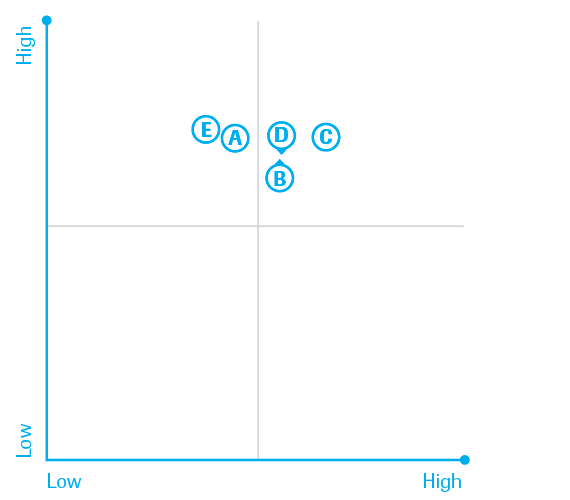
Shock
In addition, the experts believe that a loss of biodiversity and the collapse of the ecosystem would have a large to very large impact on international cooperation in the field of climate change, and this shock is therefore considered to be likely. The occurrence of this shock could have a positive effect on cooperation, however, since the urgency would become even clearer. Finally, according to the experts, a conflict between the great powers over the Arctic region would also have a large to very large impact. The experts believe that it is unlikely that this shock will actually occur, however. Unsurprisingly, such a shock would have negative consequences for the assessment of this analysis, since international cooperation would become more difficult, particularly in the Arctic region.
Conclusion
Climate change is increasingly being seen as a threat to political stability, one that will have an impact mainly in the long term. The effects of climate change that are already noticeable, such as natural disasters, are keeping the subject high on the political agenda. The question is of course whether the system of international cooperation will be able to deal with this threat and limit the effects of global warming. It is not clear whether the system of international cooperation will indeed be able to do so. On the one hand, the Paris Agreement was a tremendous boost for the multilateral tradition. On the other, the agreement and current cooperation as a whole do not really include guarantees for an effective approach.
